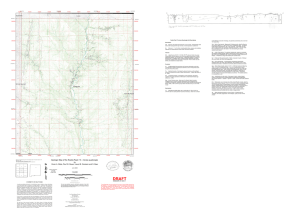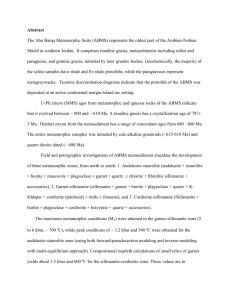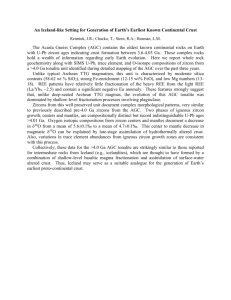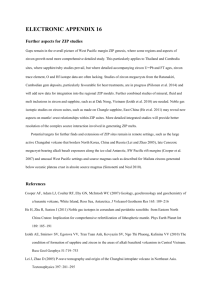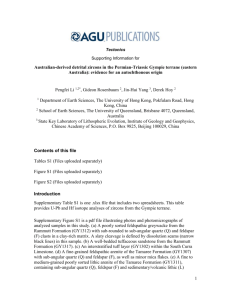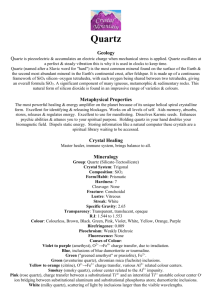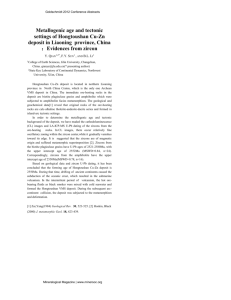Analytical method - Springer Static Content Server
advertisement
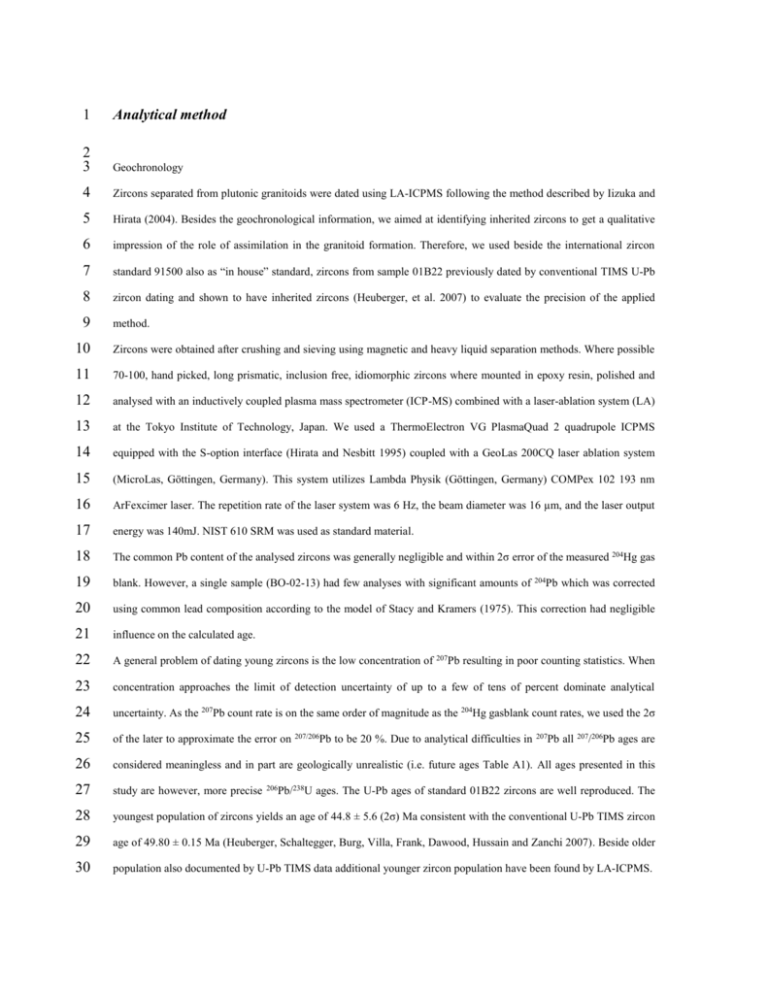
1 Analytical method 2 3 Geochronology 4 Zircons separated from plutonic granitoids were dated using LA-ICPMS following the method described by Iizuka and 5 Hirata (2004). Besides the geochronological information, we aimed at identifying inherited zircons to get a qualitative 6 impression of the role of assimilation in the granitoid formation. Therefore, we used beside the international zircon 7 standard 91500 also as “in house” standard, zircons from sample 01B22 previously dated by conventional TIMS U-Pb 8 zircon dating and shown to have inherited zircons (Heuberger, et al. 2007) to evaluate the precision of the applied 9 method. 10 Zircons were obtained after crushing and sieving using magnetic and heavy liquid separation methods. Where possible 11 70-100, hand picked, long prismatic, inclusion free, idiomorphic zircons where mounted in epoxy resin, polished and 12 analysed with an inductively coupled plasma mass spectrometer (ICP-MS) combined with a laser-ablation system (LA) 13 at the Tokyo Institute of Technology, Japan. We used a ThermoElectron VG PlasmaQuad 2 quadrupole ICPMS 14 equipped with the S-option interface (Hirata and Nesbitt 1995) coupled with a GeoLas 200CQ laser ablation system 15 (MicroLas, Göttingen, Germany). This system utilizes Lambda Physik (Göttingen, Germany) COMPex 102 193 nm 16 ArFexcimer laser. The repetition rate of the laser system was 6 Hz, the beam diameter was 16 µm, and the laser output 17 energy was 140mJ. NIST 610 SRM was used as standard material. 18 The common Pb content of the analysed zircons was generally negligible and within 2σ error of the measured 204Hg gas 19 blank. However, a single sample (BO-02-13) had few analyses with significant amounts of 20 using common lead composition according to the model of Stacy and Kramers (1975). This correction had negligible 21 influence on the calculated age. 22 A general problem of dating young zircons is the low concentration of 207Pb resulting in poor counting statistics. When 23 concentration approaches the limit of detection uncertainty of up to a few of tens of percent dominate analytical 24 uncertainty. As the 207Pb count rate is on the same order of magnitude as the 204Hg gasblank count rates, we used the 2σ 25 of the later to approximate the error on 26 considered meaningless and in part are geologically unrealistic (i.e. future ages Table A1). All ages presented in this 27 study are however, more precise 28 youngest population of zircons yields an age of 44.8 ± 5.6 (2σ) Ma consistent with the conventional U-Pb TIMS zircon 29 age of 49.80 ± 0.15 Ma (Heuberger, Schaltegger, Burg, Villa, Frank, Dawood, Hussain and Zanchi 2007). Beside older 30 population also documented by U-Pb TIMS data additional younger zircon population have been found by LA-ICPMS. 207/206Pb 206Pb/238U to be 20 %. Due to analytical difficulties in 204Pb 207Pb which was corrected all 207/206Pb ages are ages. The U-Pb ages of standard 01B22 zircons are well reproduced. The 1 It has been demonstrated (e.g. Hirata and Nesbitt 1995) that matrix-matched calibration is required in order to achieve 2 accurate LA-ICP-MS U-Pb ages for some analytical setups. However, recent studies utilizing an examiner laser with a 3 high energy density demonstrate that the analytical uncertainty due to matrix effects between the NIST 610 glass 4 standards and zircon crystal are negligible at the 2σ precision level (Iizuka and Hirata 2004). This observation is 5 consistent with the result of the “in house” standard. The TIMS U-Pb age of sample 01B22 is well reproduced even at 6 the 95% C.I. (Table A1) indicating that the 2σ probably overestimate the analytical uncertainty. Based on these results, 7 we are confident that LA-ICP-MS analyses on young, homogeneous “near” concordant zircons result in ages reflecting 8 the time of intrusion within 2σ analytical uncertainties. Averaged ages given in Table 1 are quoted with a 2σ error. 9 MSWD values have been calculated using Ken Ludwig’s isoplot program V (Ludwig 2000). 10 11 Whole rock geochemistry 12 13 Whole rock major element compositions were determined either by Acta labs (Canada) by ICP-OES and ICP-MS 14 (www.actalabs.com) or using a Rigaku RINT 2000 powder X-ray diffractometer at the Tokyo Institute of Technology, 15 Japan. For XRF analysis, samples were ground to fine powder in an agate ball mill, taking care not to include any 16 veined or weathered material, and all powders were oven-dried overnight at 105 °C. Standard glass pills have been 17 prepared using lithium tetraborate fusion method. The trace element concentration of the samples analysed by XRF 18 were determined on the XRF glass pills using XRF major element data (Al2O3) as an internal standard. For NIST 610 19 used as standard material we used the preference values of Spandler et al (in prep) 20 Trace element data have been determined on the Li2B4O7-fused XRF pellets directly using LA-ICP-MS at the 21 University of Bern. The setup consists of a GeoLas Pro 193 nm ArF excimer laser system with homogenized energy 22 density across the ablation pit (Microlas), linked with an Elan DRCe ICP quadrupole MS (Perkin Elmer). The XRF 23 pellets were broken, and analyses were performed directly on freshly broken surfaces far away from the original 24 surfaces of the pellets. Samples were loaded along with the SRM 610 glass standard from NIST in a 20 cm3 ablation 25 cell and the laser-ablation aerosol was carried to the ICP-QMS by a mixed He-Ar carrier gas. The analytical set-up was 26 tuned for optimum performance across the entire mass range. Daily optimization of the analytical conditions were done 27 to satisfy a ThO production rate of below 0.2% (i.e., Th/ThO intensity ratio < 0.002) and a Th/U sensitivity ratio of 1 as 28 determined on the SRM610 glass standard. Two analyses on the external standard at the beginning and the end of each 29 set bracketed up to 16 analyses of unknowns. A minimum of 3 shots per pellet were done to control for homogeneity of 30 the analyzed pellet. We used a 100 µm pit to lower the LOD. The certified glass standard SRM 610 was used as an 31 external standard to calibrate analyte sensitivities, and bracketing standardization provided a linear drift correction. 1 Data reduction of LA-ICP-MS analyses followed procedures described in Longerich et al. (1996). We used CaO as the 2 internal standard element to calculate trace element concentrations. Limits of detection (LOD) for each signal interval 3 were calculated for each element, for individual analyses, as three times the standard deviation of the gas background 4 signal divided by the element sensitivity (Longerich et al., 1996). 5 6 7 Sample description 8 A collateral objective of this study was to elucidate the relationship between stage 1 and stage 2 plutons in the Dir area 9 following the earlier work of Sullivan et al. (1992, e.g. their Fig 2 and 3). To begin this work, we followed the 10 description of Petterson and Windley (1985) and grouped the samples to be dated according to the presence (stage 1) or 11 absence (stage 2) of deformation fabric. Sampling resulted in stage 1 plutons (BR-02-19) from the south of the Dir 12 group and stage 2 plutons (DR-02-18, BO-02-13; MN-02-04, MR-02-03 and Rb-02-16) from the north (Figure 2). In 13 addition, we sampled a strongly deformed quartz-rich tonalite from the eastern part of the southern Kohistan Batholith 14 (C-01-77, Fig1), which has all the characteristics of stage 1 plutons (Table 1). Detailed sample descriptions are given 15 bellow: 16 17 C-01-77 (35°33´003´´N; 74°09´129´´E) 18 A strongly foliated tonalite from the southern limit of the Kohistan arc in the eastern part of Kohistan crops out near the 19 town of Chilas (Khiner valley). This tonalite contains numerous volcanic xenoliths and is crosscut by fine grained 20 amphibolitic dykes. The magmatic mineral assemblage is well preserved: plagioclase, quartz, K-feldspar, biotite, 21 allanite, epidote, FeTi-oxide, zircon and apatite. The shape of the grain aggregates is seriate – interlobate. A strong 22 foliation is defined by the orientation of biotite and quartz ribbons. Quartz crystals within the ribbons have mm-scale 23 grain size and generally show straight extinction whereas large (cm-scale) phenocrystic quartz and plagioclase crystals 24 show undulose extinction. Subgrain boundaries and deformation bands are present within quartz crystals. Plagioclase 25 and quartz crystals have interlobate grain boundaries indicating dynamic recrystallization. Tapered twins within 26 plagioclase and deformation bands in quartz crystals are frequent. In summary the textures of C-01-77 indicate strong, 27 high temperature deformation of the magmatic protolith and, accordingly, the sample displays the deformational 28 features of stage 1 plutons. 29 30 MN-02-04 (35°34´646´´N; 72°45´599´´E) 1 MN-02-04 is a coarse grained (> 1 cm) unfoliated rock with abundant volcanic xenoliths demonstrating the intrusive 2 relationship with the surrounding Dir-Utror volcanic units. The magmatic mineralogy is composed of hypidiomorphic 3 plagioclase, hornblende, quartz, biotite, K-feldspar, FeTi-oxide, zircon and apatite. A greenshist facies metamorphic 4 overprint is indicated by alteration of biotite into chlorite and titanite. Plagioclase is altered to clinozoisite and K- 5 feldspar into phengite. Stilpnomelane is present as a metamorphic phase. Quartz crystals sometimes display patchy 6 undulose extinction. Grain boundaries are generally straight; however, a few are interlobate, indicating weak grain 7 boundary migration. Accordingly sample MN-04-02 is a weakly to undeformed rock which would classify as a stage 2 8 pluton. 9 10 MR-02-03 (35°33´205´´N; 72°33´451´´E) 11 Interpretation of Landsat ETM + pictures and field observation indicate that MR-02-3 and Mn-02-04 are from the same 12 coarse grained hornblende-bearing granite body. MR-02-3 was sampled in the UshuValley, approximately 10 km to the 13 east of MN-02-04. 14 MR-02-03 is a fine-grained tonalite that intrudes the Dir-Utror volcanic units. It is locally transected by high strain 15 zones. Towards the intrusive contact, the tonalite contains abundant xenoliths of volcanic material. In the contact zone 16 apophyses are common in the volcanic country rocks. The magmatic mineralogy is composed of plagioclase, quartz, 17 biotite, minor K-feldspar, FeTi-oxide, titanite, zircon and apatite. This magmatic mineral assemblage is overprinted by 18 greenschist facies metamorphism indicated by the same mineral reaction as described for MN-02-04.A strong foliation 19 is defined by the alignment of biotite and ribbons of small (mm-big) quartz grains anastomosing around larger feldspar 20 crystals (mantle structure). Plagioclase shows frequent tapered twins. Feldspar grains are fractured with bookshelf 21 rotation of neighbouring framents. Grain boundaries are interlobate to seriate and transition from high angle grain 22 boundaries to subgrain boundaries exists. The fabric demonstrates low temperature (greenschist facies) deformation of 23 the magmatic protholith. The fabric is in accordance with stage 1 features, in contrast with the supposed stage 2 24 inferred from the fabric of sample MN-02-04. However, we attribute the low temperature deformation of MN-02-03 to 25 local thrusting along the nearby Dir Fault. 26 27 BO-02-13 (35°22´579´´N; 72°03´257´´E) 28 This medium to coarse grained quartz-diorite with volcano-sedimentary xenoliths is crosscut by tonalite dykes. The 29 magmatic paragenesis of the quartz diorite is composed of hypidiomorphic concentrically zoned plagioclase, 30 hornblende, quartz, biotite, FeTi-oxide, titanite, zircon and apatite. Magmatic hornblende is zoned with actinolite rims 31 indicating greenschist facies overprint. The rock is macroscopically unfoliated. However, in thin section cm-scale 1 plagioclase phenocrysts are separated by ca. 0.5 cm wide anastomosing quartz ribbons composed of mm-scale quartz 2 crystals. The quartz grains within the ribbons display undulose extinction and interlobate grain boundaries indicating 3 dynamic recrystallization. Accordingly the deformed rock would classify as stage 1. 4 5 RB-02-16 (35°33´712´´N; 72°12´666´´E) 6 This whitish coarse grained (~2 cm) biotite-titanite granite has a magmatic mineral assemblage that comprises quartz, 7 K-feldspar, plagioclase, biotite, allanite, FeTi-oxide, titanite, zircon and apatite. Allanite is rimed by metamorphic 8 clinozoisite. Plagioclase displays concentric zoning partly overprinted by tapered twins. K-Feldspar phenocrysts show 9 patchy undulose extinction associated with brittle fracture zones. Grain boundaries are interlobate; however, straight 10 grain contacts exist. Quartz display undulose and straight extinction. Besides the undulose K-feldspar and quartz grains 11 the rock is undeformed and therefore is classified as stage 2. 12 13 DR-02-18 (35°14´497´´N; 71°51´641´´E) 14 A coarse-grained diorite has spread numerous apophyses into the surrounding Dir-Utror volcanic rocks. The magmatic 15 mineralogy is composed of plagioclase, clinopyroxene, orthopyroxene, quartz, biotite, FeTi-oxide. Pyroxenes are partly 16 rimed by hornblende. Myrmekite is common. A weak foliation is defined by the preferred orientation of biotite. Quartz 17 crystals sometimes show undulose extinction. Grain boundary migration is demonstrated by the bulging of quartz 18 grains into plagioclase. The weak deformation features classify the rock as stage 2. 19 20 BR-02-19 (35°07´687´´N; 72°56´229´´E) 21 Like DR-02-18, this coarse grained (<1cm) quartz-diorite has many apophyses indicating intrusion into the volcanic 22 units. The granodiorite is in turn intruded by leucocratic pegmatites. The magmatic mineralogy of the dated 23 granodiorite is composed of quartz, plagioclase, K-feldspar, biotite, FeTi-oxide, zircon and apatite. The alignment of 24 biotite crystals defines the foliation. Quartz has generally undulose extinction. Deformation bands in quartz are 25 common and interlobate to seriate grain boundaries indicate dynamic recrystallization. Tapered twins in plagioclase are 26 common. Transition between high angle grain boundaries and subgrain boundaries in quartz is common. The fabric 27 indicates high-temperature deformation and therefore the sample is classified stage 1. 28 29 Table A1: Results U-Pb LA-ICPMS zircon analysis compared to conventional U-Pb TIMS ages for zircons of known 30 ages. 31 1 2 3 4 5 6 7 8 9 10 11 12 13 14 15 16 17 18 19 20 21 Heuberger S, Schaltegger U, Burg JP, Villa IM, Frank M, Dawood H, Hussain S, Zanchi A (2007) Age and isotopic constraints on magmatism along the Karakoram-Kohistan Suture Zone, NW Pakistan: Evidence for subduction and continued convergence after India-Asia collision. Swiss Journal of Geoscience DOI 10.1007/s00015-007-1203-7:24 Hirata T, Nesbitt RW (1995) U-Pb isotope geochronology of zircon; evaluation of the laser probe-inductively coupled plasma mass spectrometry technique. Geochimica et Cosmochimica Acta 59(12):2491-2500 Iizuka T, Hirata T (2004) Simultaneous determinations of U-Pb age and REE abundances for zircons using ArF excimer laser ablation-ICPMS. Geochemical Journal 38(3):229-241 Ludwig KR (2000) Isoplot/Ex version 2.4. A geochronological toolkit for Microsoft Excel. Berkeley Geochronological Centre Special Publication:56 Stacey JS, Kramers JD (1975) Approximation of terrestrial lead evolution by a two-stage model. Earth and Planetary Science Letters 26:207-221 Wiedenbeck M, Alle P, Corfu F, Griffin WL, Meier M, Oberli F, Vonquadt A, Roddick JC, Speigel W (1995) 3 Natural Zircon Standards for U-Th-Pb, Lu-Hf, Trace-Element and Ree Analyses. Geostandards Newsletter 19(1):1-23
